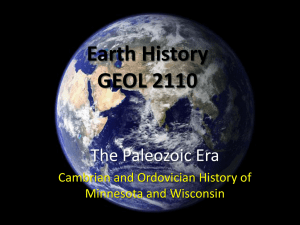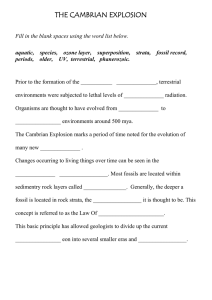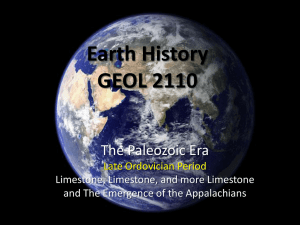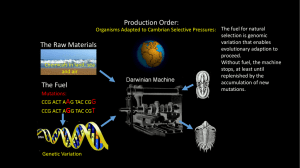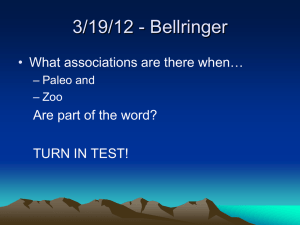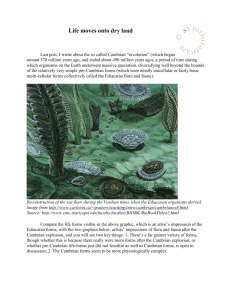Vendian, Cambrian and Early Ordovian
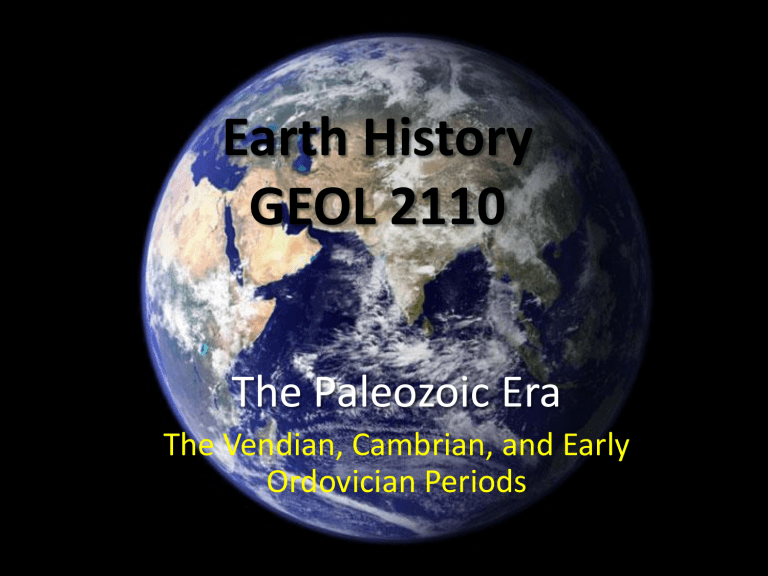
Earth History
GEOL 2110
The Paleozoic Era
The Vendian, Cambrian, and Early
Ordovician Periods
Major Concepts
• The long-lived supercontinent of Rodinia created a long period between 1,000 – 600 Ma with little deposition in the interior of most continents.
• The break-up of Rodinia, which started around 750 Ma resulted in great amounts of sediment deposited on the passive margins of the disassembled continents.
• In North America (Laurentia) great thicknesses of Vendian (610-
550 Ma) to Cambrian (550-490 Ma) sediments accumulated along it continental edges.
• Between middle Cambrian time and early Ordovician time, the dispersal of the Rodinian plates resulted in a global rise in sea level, which flooded the continents with shallow seas.
• In North America, this is called the Sauk transgression and produced sedimentation of ultrapure quartz sands and later carbonates.
Assembly of Rodinia
1200 – 750 Ma
Li et al., 2008
Li et al., 2008
Disassembly of Rodinia by a
Superplume
750 Ma
Li et al., 2008
Laurentia Becomes Modern-day Africa
Surrounded by Rifted Passive Margins
Mid-Cambrian Plate Reconstruction
Laurentia becomes Isolated and Flooded
Laurentia
Taconic Arc Baltica
Siberia
Gondwanaland glaciation
Passive Margin Sedimentation
Western US
Glacial Deposits
(Snowball Earth)
Rift Basalts
(750 Ma)
Thinning of Cambrian Sediments across the Laurentian Craton
Belt Supergroup sediments preserved in rift grabens (aulocogens)
Distribution of Cambrian Sediments over Laurentia
MCR
Warping of the Craton
• Broad horizontal tectonic stresses related to plate motion
• Sediment loading
• Isostatic adjustments due to different densities within the crust
Was Craton Warping Syn- or Post-
Depositional?
Syn-depositional Warping
Post-depositional Warping
How do we tell Structure of the Crust?
Sedimentary Facies and Paleogeography of
Late Cambrian Sedimentary Deposits
Ultrapure Quartz Cambrian Sandstone
MN/WI Strat Column
Jordan SS
95-99% Quartz
Well Rounded
Well Sorted
Depositional
Environment
Shallow Marine or Eolian?
Abraided quartz grains - Eolian
Mod–angle cross stratification -Eolian
Low –angle cross stratification -Marine
Both
Eolian – early transport
Marine – final deposition
How Shallow is Shallow Marine?
Flat-pebble
Conglomerates
Storm Rip-ups of the Seafloor
Oolitic Carbonates
Agitated Water
Stromatolitic Limestone
Fossilized Algal Mats
Tidal
Mud Cracks
Periodic
Drying
Modern Day Analog to the Sauk Sea
Gulf of Mexico
• <200 Meters Deep
• Carbonate deposition in detrital sediment starved areas
Differences
• ¼ the area of Sauk Sea
• Coral reefs not present until Silurian
• No land vegetation in
Cambrian - fine sediment winnowed from land by wind
Actualism
Deposition accomplished mostly by Hurricanes
“Fossil Hash” -
Mass-kills from
Hurricanes
Next Lecture
The Paleozoic Era
Part 2: Late Ordovician Period
Limestone, Limestone, and more Limestone and The Emergence of the Appalachians

